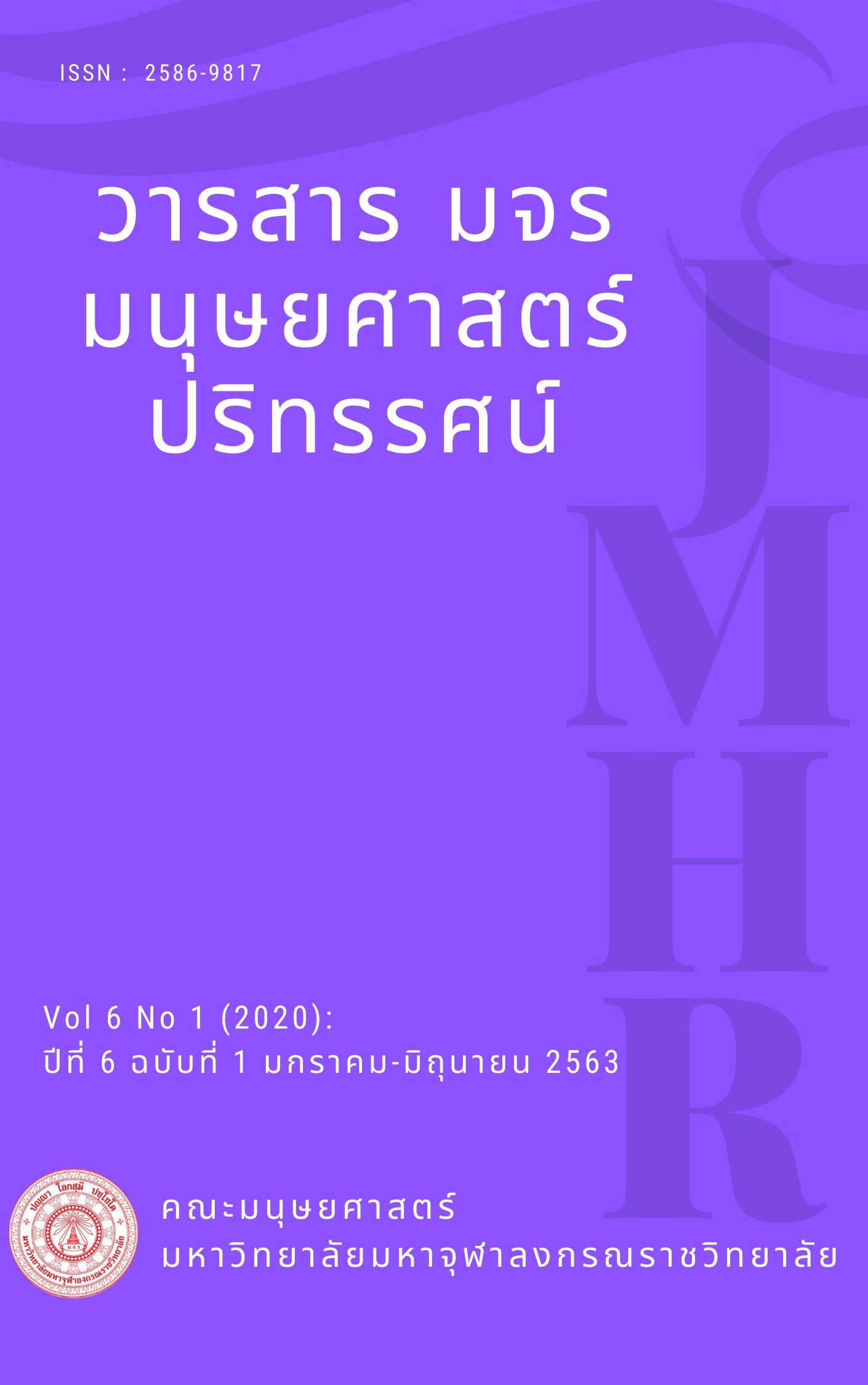การพัฒนาพฤติกรรมเชิงสร้างสรรค์สำหรับเยาวชน โดยใช้สื่อตามแนวพุทธจิตวิทยา
คำสำคัญ:
เยาวชน, สื่อโซเชี่ยล, พฤติกรรมเชิงสร้างสรรค์บทคัดย่อ
การวิจัยเรื่อง “การพัฒนาพฤติกรรมเชิงสร้างสรรค์สำหรับเยาวชนโดยใช้สื่อตามแนวพุทธจิตวิทยา” มีวัตถุประสงค์ 1) เพื่อศึกษาแนวคิด ทฤษฎีการพัฒนาพฤติกรรมเชิงสร้างสรรค์โดยใช้สื่อตามแนวทางพระพุทธศาสนาและทางจิตวิทยา 2) เพื่อออกแบบกิจกรรมการพัฒนาพฤติกรรมเชิงสร้างสรรค์โดยใช้สื่อตามแนวพุทธจิตวิทยาสำหรับเยาวชน 3) เพื่อทดลองใช้กิจกรรมพัฒนาพฤติกรรมเชิงสร้างสรรค์และเสนอผลการพัฒนาพฤติกรรมเชิงสร้างสรรค์โดยใช้สื่อตามแนวพุทธจิตวิทยาสำหรับเยาวชน กลุ่มตัวอย่าง ได้แก่ เยาวชนชั้นมัธยมศึกษาปีที่ 3 โรงเรียนอำนวยวิทย์ จำนวน 30 คน คัดเลือกแบบเจาะจง ใช้วิธีดำเนินวิจัยกึ่งทดลอง เครื่องมือที่ใช้ในการวิจัย ได้แก่ แบบวัดการเปลี่ยนแปลงพฤติกรรมการใช้สื่อโซเชียล และชุดกิจกรรมการพัฒนาพฤติกรรมเชิงสร้างสรรค์ วิเคราะห์ข้อมูลเชิงปริมาณใช้สถิติ t-test และวิเคราะห์ข้อมูลเชิงคุณภาพด้วยวิธีวิเคราะห์เนื้อหา ผลการวิจัยวิเคราะห์ตามวัตถุประสงค์ ดังนี้
1) เยาวชนมีการใช้สื่อโซเชียลไม่สร้างสรรค์ ใช้เวลามากเกินความจำเป็น ควรมีการจัดกิจกรรมให้ความรู้โดยการนำหลักธรรมทางพระพุทธศาสนามาประยุกต์ใช้เพื่อให้เยาวชนรู้จักแยกแยะคุณและโทษ และมีการพัฒนาพฤติกรรมการใช้สื่อโซเชียลอย่างสร้างสรรค์
2) กิจกรรมการใช้สื่อโซเชียลที่เหมาะสมสำหรับเยาวชนได้แก่ กระบวนการพัฒนาพฤติกรรมเชิงสร้างสรรค์ตามหลักไตรสิกขา และการเปลี่ยนแปลงพฤติกรรมการใช้สื่อโซเชียล 4 ด้าน ได้แก่ ด้านปัญญา จิตใจ กายภาพ และสังคม และหลักภาวนา 4 การพัฒนาและแสดงออกผ่านพฤติกรรมทางกาย วาจา และหลักโยนิโสมนสิการ เป็นการฝึกการใช้ความคิดอย่างถูกวิธี
3) การพัฒนาพฤติกรรมเชิงสร้างสรรค์โดยผลการเปรียบเทียบคะแนนเฉลี่ยก่อนและหลังการเข้าร่วมกิจกรรมพบว่ามีคะแนนเฉลี่ยแตกต่างกันอย่างมีนัยสำคัญทางสถิติที่ระดับ .05
เอกสารอ้างอิง
กมลาศ ภูวชนาธิพงศ์ และคณะ. (2560). ค่านิยมและพฤติกรรมต้นแบบใช้เครือข่ายสังคมออนไลน์ตามแนวพุทธจิตวิทยาบูรณาการของสามเณร. วารสารสันติศึกษาปริทรรศน์ มจร, 5(2), 43.
กมลาศ ภูวชนาธิพงศ์ และ พุทธชาติ แผนสมบุญ. (2560). Smart Novices สามเณรยุคศตวรรษ 21 ทำโครงงานนวัตกรรมสร้างสรรค์เพื่อชุมชน. สืบค้น 25 พฤษภาคม 2562, จาก https://www.matichon.co.th/education/news_580707
จินตนา ตันสุวรรณนนท์ และคณะ. (2553). ปัจจัยที่เกี่ยวข้องกับพฤติกรรมการบริโภคสื่อด้วยปัญญาของนักศึกษาระดับอุดมศึกษาในเขตกรุงเทพมหานคร. วารสารพฤติกรรมศาสตร์, 16(1), 121-135.
นรินทร ศิริไทย. (2547). ความรู้เรื่องการรู้เท่าทันสื่อเพื่อสุขภาพภูมิคุ้มกันสุขภาพที่ดีสำหรับเด็กและเยาวชนในการพัฒนาองค์ความรู้การรู้เท่าทันสื่อสุขภาพ สู่หลักสูตรในระบบและนอกระบบการศึกษาของไทย. กรุงเทพฯ: สำนักงานกองทุนสนับสนุนการสร้างเสริมสุขภาพ.
พระธรรมปิฎก (ป.อ.ปยุตฺโต). (2546). พัฒนาการแบบองค์รวมของเด็กไทย. กรุงเทพฯ: ธรรมสภาและสถาบันบันลือธรรม.
“____________”. (2552). การศึกษาทั่วไปเพื่อพัฒนามนุษย์. กรุงเทพฯ: มหาวิทยาลัยศรีนครินทรวิโรฒ.
พระมหากำพล คุณงฺกโร. (2557). การพัฒนาเยาวชนแนวพุทธ The development of the youths According to the Buddhist Way. วารสารมหาวิทยาลัยนราธิวาสราชนครินทร์ สาขามนุษย์ศาสตร์และสังคมศาสตร์, 1(2), 78.
วันวิสา สรีระศาสตร์. (2555). ปัจจัยเชิงสาเหตุด้านสถานการณ์ทางสังคม และการมีภูมิคุ้มกันทางจิตที่เกี่ยวข้องกับพฤติกรรมการใช้อินเทอร์เน็ตอย่างสร้างสรรค์และปลอดภัยของนักเรียนหญิงระดับมัธยมศึกษาในโรงเรียนที่เข้าร่วมและไม่เข้าร่วมโครงการส่งเสริมการใช้อินเทอร์เน็ตอย่างสร้างสรรค์และปลอดภัย. วารสารพฤติกรรมศาสตร์เพื่อการพัฒนา, 4(1), 1-13.
สำนักงานส่งเสริมเศรษฐกิจดิจิทัล (ดีป้า) กระทรวงดิจิทัลเพื่อเศรษฐกิจและสังคม. The 2018 DQ Impact Report. สืบค้น 9 เมษายน 2562, จาก http://www.depa.or.th/th/news/cyberbullying
Johnson, David W. & Johnson, Roger T. (1994). Learning Together and Alone : Cooperative and Individualistic Learning (4th ed). Boston : Allyn and Bacon.
Takington, S.A.. (1998). Improving Critical Thinking Skills Using Paideia Seminars in a seven-Grade Literature Curriculum (Doctoral Dissertation). University of San Diego. USA.
Dillon, J.T. (1984). Research on Questioning and Discussion. Educational leadership, 42(3), 50-56.

ดาวน์โหลด
เผยแพร่แล้ว
รูปแบบการอ้างอิง
ฉบับ
ประเภทบทความ
สัญญาอนุญาต
ลิขสิทธิ์ (c) 2020 วารสาร มจร มนุษยศาสตร์ปริทรรศน์

อนุญาตภายใต้เงื่อนไข Creative Commons Attribution-NonCommercial-NoDerivatives 4.0 International License.





